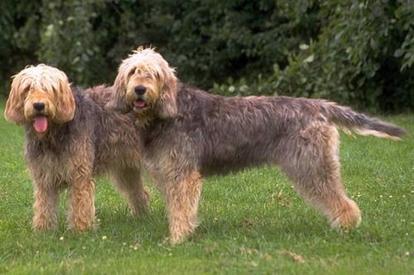
The Otterhound originates from...
The beginnings of the Otterhound are uncertain, although it is first referenced as early as 1175, making it amongst the ancient breeds. River otters were a progressive nuisance for fishermen in Medieval England as they competed for the fish stock. For this reason, packs of Otterhounds were used in hunting the otters and reducing their numbers. Several factors contributed to the decline of the breed, with water pollution being the leading cause before the sport of otter hunting was outlawed in 1978. It is thought that the Otterhound derives from the Bloodhound and French Griffon, with or without the contribution of Harrier blood. The modern Otterhound evolved in the 18th century and remains today the most endangered dog native to Britain. Recognised by the American Kennel Club in 1909.
The Otterhound is characterised by...
One of the ancestral breeds of the Airedale Terrier, the Otterhound bears a striking resemblance to its supposed forebears. With a large, rectangular frame, strong legs, a relatively narrow head, large pendant ears, and a straight top line, they are proportioned and distinctive. Their coat is weatherproof, rendering it suitable for swimming, and is a combination of soft and coarse hairs. Common colours include variations of wheaten and grizzle, usually with black markings. It boasts an acute sense of smell and has a natural affinity with water, being a confident and enthusiastic swimmer. These dogs can also be observed hunting mink, bear, and raccoons in some parts of the world.
The average Otterhound...
A typical hound, they boast sharp sight and smell senses, as well as vigilance and stamina. Despite their early usage, the modern breed is commonly observed as a companion dog, known for its gentle and easy temperament. Inherently energetic and curious, they require careful management, but their fun-loving nature makes them the ideal breed choice for families or the dedicated sole owner. On average, a healthy Otterhound will weigh between 30-52kg, with a life expectancy of 10-15 years when shown appropriate love and care.
Weaknesses...
Despite being generally healthy and robust, various health afflictions are identified in the breed. These range from mild to more serious. As with most canines, hip and elbow dysplasia, arthritis, and associated orthopaedic complaints are well documented. They are also susceptible to epilepsy and seizures, with ear infections being prevalent. Most large-size, deep-chested breeds are prone to bloat and gastric torsion, two potentially fatal conditions if left untreated for any length of time.
Browse more breed facts and information or take a look at our digestion care range and joint care.
Do you own a Otterhound? Let others know what they're like!
Related products
Advantage 80 Spot On Flea Control Large Cats and Rabbits
from £12.95
Advantage 40 Spot On Flea Control Cats, Small Dogs and Rabbits
from £12.95
Advantage 100 Spot On Flea Control Medium Dog
from £12.95
Advantage 250 Spot On Flea Control Large Dog
from £12.95
Drontal Tasty Bone Wormer Tablets for Small & Medium Dogs (2 to 20kg)
from £2.15
FRONTLINE Plus Flea & Tick Treatment Dogs & Cats
from £17.49
TermaWorm™ Tablets for Cats & Dogs
from £1.59
Drontal Tasty Bone XL Wormer Tablets for Large Dogs (Over 20kg)
from £6.39